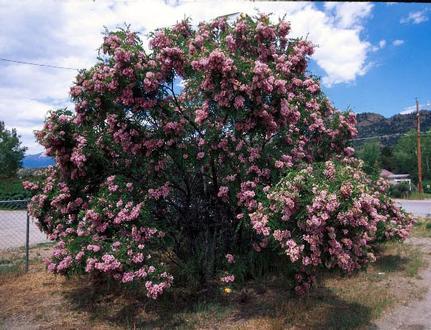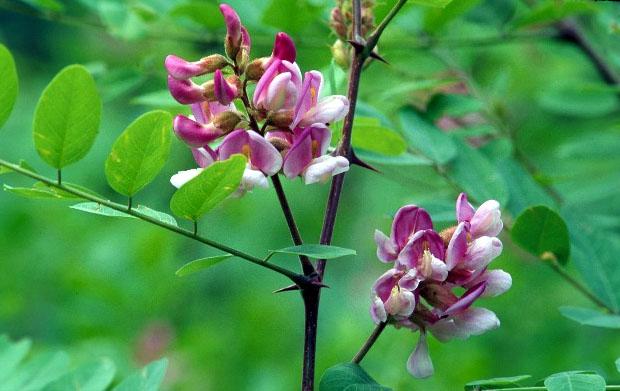Locust, New Mexican
Robinia neomexicana
Fabaceae - Legume
Description
Leaves: Alternate; once pinnately compound; 6" to 10" long; deciduous; 9 to 21 oblong, oval leaflets, 1" to 1-1/2" long, with entire margins, a bristle tip, and no stalks, covered with gland-tipped hairs; dark green in summer; yellow fall color.
Twigs/buds: Twigs moderately stout; often zigzag; covered with glandular hairs (hairs with small swellings at the tips); generally with medium-length, stiff spines, 1/2" long, in pairs at bases of leaves. No terminal bud; lateral buds hidden under cracks of bark near leaf scar.
Flowers/fruit: Flowers perfect, pink to white, 1" wide, pea-like; arranged in 4" to 8" long groups; attractive and fragrant; blooms in late spring. Fruit a brown, flat legume; 3" to 4" long; containing 4-8 flat brown seeds; covered with bristly hairs.
Bark: Light gray to brown; thin; shallowly furrowed.
Wood: Little information available; unimportant. Growth rings distinct; ring-porous.
General: A small tree or shrub native to the southwestern U.S., including Utah. Nitrogen fixer. Browsed by wildlife and livestock. Readily produces sucker sprouts. Shade intolerant.
Landscape Use: Seldom used but could be used more, especially in naturalized landscapes and tough situations. Very drought tolerant and able to withstand tough conditions, though susceptible to locust borer damage. Zones 5(4?)-9.
Comments & Limitations: Thorns or spines that can be dangerous; use thornless varieties if possible.
Characteristics
General
| Family | Fabaceae - Legume |
|---|---|
| Cultivar Availability | No |
| Hardiness Zone | 5-9 |
| Type | Broadleaf |
| Utah Native | Yes |
Growth
| Growth Rate | Medium |
|---|---|
| Mature Height | Medium |
| Longevity | Medium |
| Is Good Under Power Lines | No |
| Crown Shapes | Oval |
Ornamental
| Bark | No |
|---|---|
| Fall Color | No |
| Flowers | Yes |
| Foliage | Yes |
| Fruit | No |
Tolerance
| Shade | Low |
|---|---|
| Salt | High |
| Drought | High |
| Poor Drainage | Medium |
| Alkalinity | High |
| Transplanting | High |





